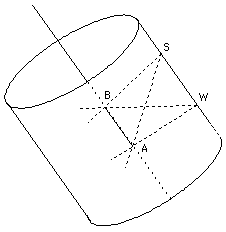The reason why the pointer (│gnomon▓) of the sundial is aimed towards the celestial pole.
It is assumed here we are north of the equator, and the gnomon points to the north pole of the sky.

- Let AB in the drawing represent the pointer of a sundial, aimed at the celestial pole, parallel to the Earth╣s axis.
- Usually the stars and Sun are visualized as attached to a rotating │celestial sphere.▓ For explaining the sundial, however, it is more convenient to visualize them as attached to a rotating cylinder, with AB on its axis.
- The cylinder can be viewed as marked with many straight lines parallel to AB. Each time of the day has such a line, marking where the Sun is at that time of the day. Let SW be that line for some particular time.
- Consider two dates in the year, one in summer, one in winter. At the summer date, at the chosen time, the Sun is high in the sky. at point S, while at the winter date, it is low in the sky, at point W.
- The shadow of the gnomon is always in the plane containing the Sun and the points A and B.
If AB is a thin line, the shadow will also be a thin line, the intersection of this plane with the base of the sundial.
- In summer, therefore, the shadow is in the plane SAB, and in the winter, in the plane WAB.
- However, because AB points along the axis of the cylinder, the lines SW and AB are parallel, like opposite sides of a page. All 4 points are therefore in the same plane, and the two planes (S,A,B) and (W,A,B) are one and the same.
Summer or winter, the shadow is therefore along the same line, the intersection of the above plane and the base of the sundial.
- Suppose the pointer had a different direction, out of the plane of the paper. Then the planes SAB and WAB would be different, and their intersections with the base--which are the shadows cast by the pointer, at that time but on two different dates--are also different.
|